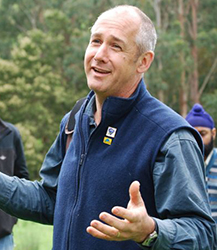Red Ironbark
Eucalyptus tricarpa, sideroxylon and crebra

The most valuable eucalypt
Why doesn't everyone just plant Red Ironbark?
In the timber game, high value reflects a balance of usefulness, reputation, scarcity and demand. In all respects I can think of no other eucalypt species that comes close to Red Ironbark. But, can we grow the same quality in plantations?
Red Ironbark is an excellent timber and highly regarded for almost every purpose from firewood and landscaping through to high value appearance grade timber. The common name, Red Ironbark, refers to at least three equally important tree species: Eucalyptus tricarpa, Eucalyptus sideroxylonand Eucalyptus crebra. In all cases the timber is dark red and has Class 1 durability (Life expectancy of over 25 years in the ground).
Red Ironbark does grow in plantations. Early growth rates are slow compared to the high rainfall eucalypts but it is during the dry years that the Red Ironbark proves its worth: I've seen many low rainfall sites where Blue Gum and Flooded Gum died out during the drought but the Red Ironbark just kept on growing. Add to this its tolerance of water logging and frost and you have an ideal species for poor, infertile shallow soils (sands, gravels, ironstones and clays) which should never have been cleared for farming.
CSIRO has studied the wood quality of unmanaged farm grown Red Ironbark. The results suggest that, in terms of colour and wood density, the increased growth rates expected on farm sites is not an issue.
In plantations, the sapwood band is likely to be wider in fast growing trees but this simply reflects the water demands of a large healthy canopy. If this is a problem it might be necessary to let the trees grow a little bigger than 60cm diameter. I actually think that once Red Ironbark trees reach sawlog size it would be more profitable to lightly thin the plantation and let the best trees grow out to at least 80cm or more rather than clearfell the lot.
Achieving a straight stem to a reasonable height is still a challenge although breeding and selection work with Red Ironbark is helping identify families with better form. The bark is very thick and this must be taken into consideration when assessing the volume of standing trees. Straight logs mill well and the timber dries with little degrade. The colour and density of young fast grown timber may be lighter in the central core but this is unlikely to distract from its market value.
Online information about growing Red Ironbark:
For Victoria and Southern NSW
http://new.dpi.vic.gov.au/notes/foestry/farm-forestry/ag0901-private-native-forestry2
For Queensland and Northern NSW
http://www.dpi.qld.gov.au/26_5447.htm
